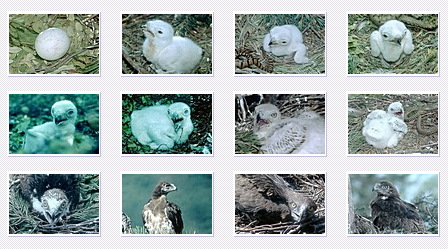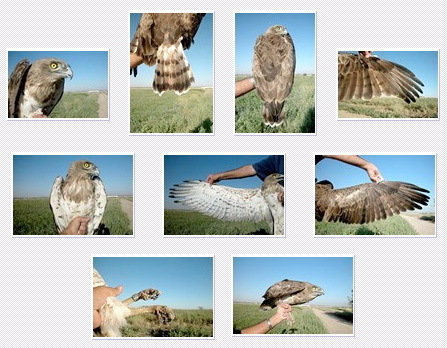Enjoy new series of Vincenzo Rizzo Pinna’s videos. These clips show moments of Short-toed Eagles’ life during the breeding season of 2008. Like previous ones they are about the Eagles of the Maremma Regional Park /map/. Some of them are made by infrared camera.
Category: People ›
Photos of different aged Short-toed Eagle chicks
Aug 26, 2008 / CommentPhotos of different aged Short-toed Eagle chicks are made by Jean-Pierre Malafosse and are published now by courtesy of the author.
They can be helpful to researchers for estimated determination of the chicks’ age.
Short-toed Eagles near Marseille
Aug 23, 2008 / CommentThis text about nesting Short-toed Eagles in the environs of Marseille as an example of the species adaptation to urbanization is offered by Richard Frèze:
• Richard Frèze, 2008 – Un Circaète aux portes de Marseille [Short-toed Eagle near Marseille] (Fr). Also you have a possibility to open a PDF  {rough translation} of the article, to view /map//map/ and photos.
{rough translation} of the article, to view /map//map/ and photos.
Short-toed Eagle chick in Mizhrichynskyi Park
Aug 3, 2008 / 1 CommentThese photos of Short-toed Eagle chick (© Konstantin Pismennyi) were made on a territory of Mizhrichynskyi Regional Landscape Park /map/. The chick was 6-7 weeks old. The whole population of Short-toed Eagles is estimated now as about 10 territorial pairs.
You can read more about birds of prey of Mizhrichynskyi Park on a website of Ukrainian Birds of Prey Research Centre. The information is prepared by Sergey Domashevsky there.
A new Tv short news about Short-toed Eagle aggregation
Jul 12, 2008 / 2 CommentsBy Amir Balaban. Language Hebrew, but who needs to listen when you have what to see…
enjoy the link
Sameh
Biotopes. Retuerta de Pina (Spain)
Jul 5, 2008 / CommentPlease take a look at the map of the area. General botanical description and a photo can be viewed below:
 La Retuerta is situated in the central part of the Ebro valley, east of Zaragoza, in northeastern Spain. The extreme climatic conditions of the area have produced a vegetation similar to that of the North-African steppes. This climate can be summarized as follows: large annual range of minimum and maximum temperatures, oscillating from -10 oC to more than +40 oC; frequent frost in spring; prevailing winds from the NW and the SE (cold and warm, respectively), both with great desiccating power; low annual rainfall (200-400 mm); water deficit over 300 mm.
La Retuerta is situated in the central part of the Ebro valley, east of Zaragoza, in northeastern Spain. The extreme climatic conditions of the area have produced a vegetation similar to that of the North-African steppes. This climate can be summarized as follows: large annual range of minimum and maximum temperatures, oscillating from -10 oC to more than +40 oC; frequent frost in spring; prevailing winds from the NW and the SE (cold and warm, respectively), both with great desiccating power; low annual rainfall (200-400 mm); water deficit over 300 mm.
Illustrations to Javier Blasco-Zumeta’s pdf
Jun 19, 2008 / CommentHeartful thanks to Javier Blasco-Zumeta for few fullsized illustrations to his information sheet! They are represented below:





